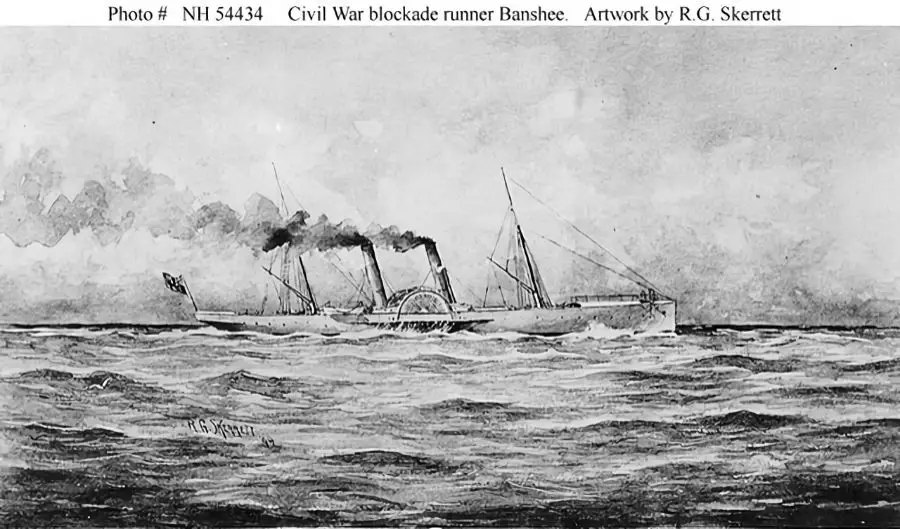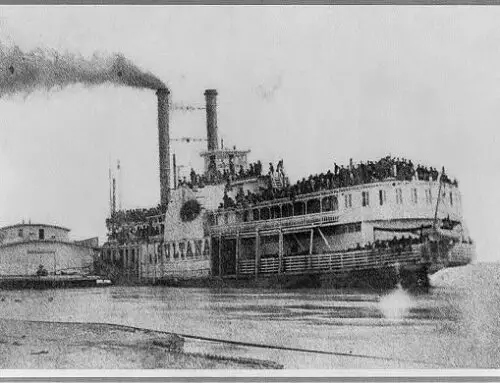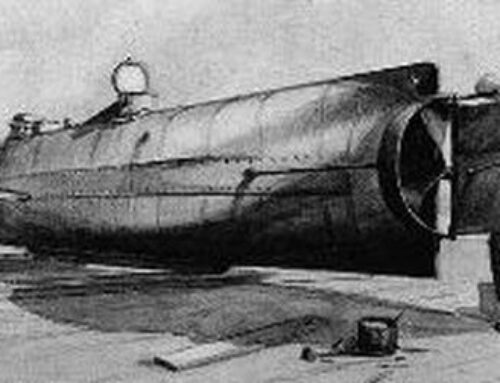Blockade runners were ships that attempted to get through the Union blockade of Southern waters during the Civil War.
As the Civil War raged on, the Union sought to cripple the Confederate economy by imposing a naval blockade on Southern ports. This strategy, known as the Anaconda Plan, aimed to cut off the Confederacy from crucial supplies and resources, ultimately forcing them into submission. The blockade was extensive, covering over 3,500 miles of coastline, and involved hundreds of Union ships patrolling the waters.

Blockade Runners – CSS Banshee
The Confederate Navy was never in any position to challenge the Union Navy in a full out battle. They simply lacked any real fighting ships and would be easily defeated. Their only alternative was to come up with innovative ways to deal with the Union Navy. They employed the use of a submarine the H.L. Hunley to try and break up the blockade.
This proved partly successful sinking one Union warship the USS Housatonic, however the Hunley was also lost in the same attack. Ending the South’s submarine ambitions.
The South also used the ironclad Virginia to attack the blockading ships, this however proved somewhat ineffective when the Union sent their own ironclad, the USS Monitor to intercept and stop the Virginia. The South did have one way that proved to be successful. This was simply running the blockade and not trying to fight it.
Enter the Blockade Runners: Stealth and Speed
In response to the Union blockade, the Confederacy turned to blockade runners – individuals and ships that specialized in evading the watchful eyes of Union forces to smuggle goods in and out of the South. Blockade runners were essential for the Confederacy, providing them with vital supplies, such as weapons, ammunition, and medicine, as well as luxury items that boosted morale among the population.
The Blockade Runners: Built for Speed and Evasion
Blockade runners relied on fast, nimble ships to slip past the Union navy. These vessels were typically steam-powered, with a shallow draft to navigate the shallow waters near the coast. They were designed for maximum speed and maneuverability, with narrow hulls and powerful engines. Many were painted gray or black to blend in with the sea and night sky, some ships were equipped with retractable smokestacks to minimize their visibility.
A High-Stakes Game
The world of blockade running was a high-stakes, dangerous endeavor. Runners had to be skilled navigators and tacticians, using their knowledge of local waters and the movements of Union ships to plot a safe course. They often relied on moonless nights and foggy conditions to cloak their movements, timing their runs to coincide with the changing tides.
Blockade runners also employed a variety of tactics to evade capture. Some would fly false flags, posing as neutral or Union vessels to deceive their pursuers. Others would jettison their cargo overboard if they were in danger of being caught, hoping to retrieve it later or at least deny it to the Union.
Five of the Most Famous Blockade Runners
CSS Robert E. Lee: This Confederate-operated blockade runner, originally named the Giraffe, was renamed after the famous Confederate General. The CSS Robert E. Lee saw service in both the Atlantic and the Gulf of Mexico. With a reputation for speed and stealth, the ship managed to carry out 21 successful runs, bringing in valuable cargo for the Confederate cause before being captured on November 9th 1863.
CSS Advance: A highly successful Confederate blockade runner, the CSS Advance made a total of 17 successful runs before being captured by Union forces on September 10th 1864.
CSS Banshee: This British-built, Confederate-operated blockade runner was known for its speed and agility, making seven successful runs in 1863 before being captured on November 21st 1863.
CSS Syren: Often considered one of the most successful blockade runner ships, the SS Syren made 33 successful runs between Nassau and Charleston. Known for her speed and stealth, she played a crucial role in transporting much-needed supplies to the Confederate forces.
CSS Owl: The SS Owl was another fast and elusive blockade runner that saw great success during the Civil War. This British-built ship was known for her speed and ability to outrun Union vessels, making several successful runs between Nassau and Wilmington, North Carolina.
Notable Blockade Runner Individuals
Thomas E. Taylor: A British businessman and blockade runner, Thomas E. Taylor played a key role in the Confederacy’s overseas smuggling operations. Coordinating the shipment of goods from Europe to the Confederate States, Taylor’s extensive network of contacts and resources ensured the success of many blockade-running missions.
Captain John Newland Maffitt: An experienced sailor and Confederate naval officer, Captain John Newland Maffitt commanded the CSS Florida, a powerful cruiser used for blockade running. Under Maffitt’s leadership, the Florida captured and destroyed numerous Union vessels, significantly disrupting their maritime operations.
The Unseen Support Network:
The role of blockade runners in the Civil War was not limited to the daring captains and crews who risked their lives on the high seas. A vast network of individuals on both sides of the Atlantic worked tirelessly to support these maritime operations.
From shipbuilders who constructed the fast, sleek vessels to the financiers who bankrolled the missions and the spies who provided valuable intelligence, many people played a part in this dangerous game.
Technological Innovations: The blockade runners of the Civil War spurred a number of technological innovations in maritime engineering. The demand for speed and stealth led to the development of new ship designs, propulsion systems, and navigational tools. These advancements would go on to influence the design of future naval vessels and play a role in shaping the course of maritime history.
International Implications: The presence of foreign-built and financed blockade runners created a complex web of international intrigue during the Civil War. The British government, while officially neutral, was sympathetic to the Confederate cause and provided support in the form of shipbuilding and financing. This involvement strained relations between the United States and Britain, leading to a series of diplomatic incidents and near-conflicts.
Enduring Mystique: The blockade runners’ exploits have captured the imagination of historians and the general public alike. Their daring missions, high-stakes gambles, and narrow escapes from capture have provided the basis for countless novels, films, and works of historical fiction. In the years since the Civil War, the blockade runner has become a symbol of courage, resourcefulness, and defiance in the face of overwhelming odds.
The End of an Era: The Fall of the Blockade Runners
As the Civil War progressed, the Union navy’s blockade became increasingly effective. Advances in technology, such as faster ships and improved surveillance methods, made it harder for blockade runners to slip through the net. By the end of the war, the once-thriving trade had been all but extinguished.
Conclusion
The blockade runners of the Civil War played a pivotal role in shaping the course of the conflict, defying the Union’s efforts to starve the Confederacy into submission. Their fast, stealthy ships, operated by daring and skilled crews, outmaneuvered the Union navy and provided the South with the resources it needed to continue the fight. The impact of the blockade runners was felt not just during the war, but in the years that followed, as the technological innovations they inspired and the international tensions they created continued to reverberate through history. Today, the blockade runner stands as a testament to the power of determination and ingenuity in the face of seemingly insurmountable challenges.
FAQ’s – Civil War Blockade Runners
What factors made blockade running a high-risk endeavor?
The risks associated with blockade running included the ever-present threat of capture by Union forces, the unpredictable nature of the sea and weather conditions, and the constant need for stealth and cunning to avoid detection.
Did blockade runners only smuggle goods into the Confederacy?
While the primary purpose of blockade runners was to bring essential supplies into the Confederacy, they also exported goods like cotton to European markets, which helped to finance the Confederate war effort.
What happened to captured blockade runners and their crews?
Captured blockade runners and their crews faced various consequences, such as imprisonment, confiscation of their vessels and cargo, and potential charges of piracy, which could result in severe punishment.
Were there any famous blockade runners during the Civil War?
Some notable blockade runners included the CSS Advance, CSS Robert E. Lee, CSS Bat, CSS Owl, CSS Banshee, and the CSS Syren, as well as individuals like Thomas E. Taylor and Captain John Newland Maffitt.
How did blockade running impact the outcome of the Civil War?
Blockade running helped to prolong the conflict by supplying the Confederacy with much-needed resources. However, the increasing effectiveness of the Union blockade over time contributed to the eventual collapse of the Confederate economy and surrender.


